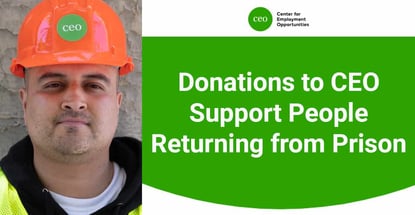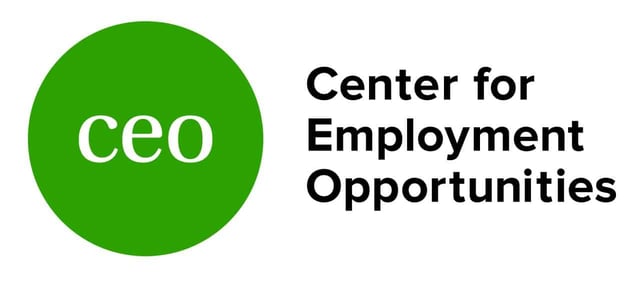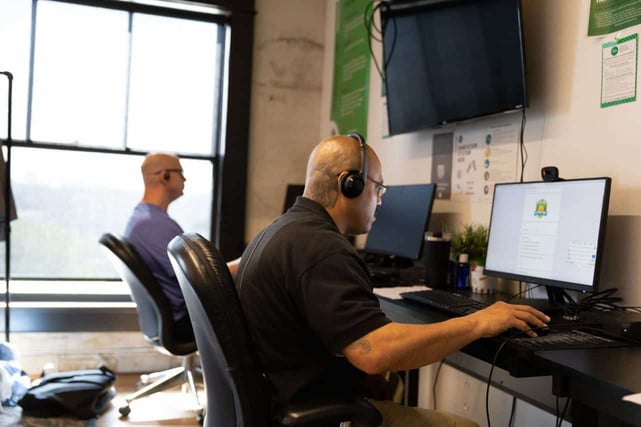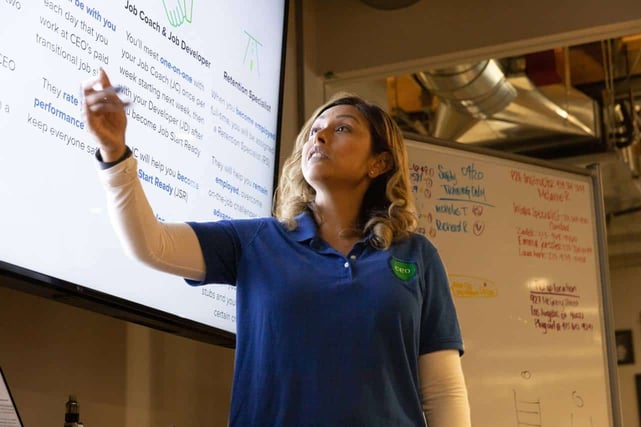
Our experts and industry insiders blog the latest news, studies and current events from inside the credit card industry. Our articles follow strict editorial guidelines.
In a Nutshell: People returning to society from prison face the constant challenge of finding a job and contributing sustainably to their community. The nonprofit Center for Employment Opportunities has worked for more than 30 years to reduce recidivism in the US through paid employment, skills training, and ongoing career support. Everyone has the potential to build a brighter future for themselves, their families, and their communities. Card rewards and other donations help the Center for Employment Opportunities give more people that chance.
If you’re any sort of movie buff, you know the scene where the grizzled prisoner finally wins release after many years inside. The warden hands him his few possessions and a bus ticket to the nearest town, and the prisoner steps out, alone, into an indifferent world he’s unprepared to face.
The problem with that cliche is it isn’t far from the truth. America’s culture of incarceration leans way too much on punishment and not nearly enough on the potential for people to remake themselves.
It doesn’t just hurt former prisoners trying to connect with opportunity and avoid a cycle of despair leading to reincarceration. It hurts families, businesses, and communities in ways that seem counterproductive to its intention. Changing mindsets creates wins for everyone.

That’s the argument of the nonprofit Center for Employment Opportunities (CEO), which has worked for more than 30 years to replace recidivism with successful reentry into society for people returning home from prison. CEO contends that all it takes is a little help to put people on a positive footing and establish new life patterns and lasting success.
CEO’s Theory of Change posits that when people returning home from prison can augment short-term paid transitional employment with life skills education, full-time job placement, and post-placement services, they’re less likely to experience reincarceration and more likely to pursue a stable, productive life.
That’s the CEO program. Research from CEO shows a more than three-to-one cost versus taxpayer savings benefit for government and positive employment impacts for participants up to three years after release.
“Within two days of enrolling in our program, we get individuals working, and we pay them and give them coaching and feedback every day,” said CEO’s president, Samra Haider. “Plus, the work we do is real work, we have real customers who rely on CEO for important services.”
Transitional Work Crews Operate in 31 Cities
About 40% of CEO’s budget comes from earned revenue for services it provides — the real work Haider alludes to. Another 35% comes from government funding sources focused on employment and training. That leaves a substantial gap that CEO fills through foundation support, corporate philanthropy, and individual contributions.
When more individuals donate their card rewards and make other financial contributions to CEO, it has more resources to expand programs that provide tech skills and tools for achieving success beyond entry level. Donors may also join the Fair Change Society and make monthly contributions.

However, immediate paid employment always comes first. Only when participants can provide for basic needs can they be receptive to skills training and ongoing career support. In return for completing a brief paid orientation, participants receive up to four days a week of transitional work on a crew and daily pay.
The work is entry-level and can be physical. It could be road beautification, park maintenance, warehouse labor, or any work individuals can perform immediately in a crew or team environment.
“We’re providing a structure to get them in a job, develop their skills, and point them toward a free and fulfilling future,” Haider said.
CEO underwent an extensive expansion beginning in the mid-2010s and extending into the pandemic. As of spring 2023, it enrolls 8,000+ individuals annually and manages more than 450 daily. More than 100 transitional work crews operate in 31 cities across the country. The vast majority of workers are male people of color, and 51% are between 18-30 years of age.
“Half of our folks have never worked before, and the rest have limited history,” Haider said. “We’re trying to get them reacclimated to work quickly, but we’ve invested a lot in our digital skills to prepare them for the workforce now, which has different requirements than it did years ago.”
Outreach and Advocacy Promote Inclusive Employment
Although Haider and CEO recognize the obvious demand for its services in far more cities and sites than it currently operates, post-pandemic expansion isn’t proceeding as quickly as it might because CEO insists on providing authentic work experiences.
Unfortunately, that’s easier said than done. CEO has succeeded in placing participants in many small- to medium-sized businesses, where founders and entrepreneurs demonstrate greater receptivity on a case-by-case basis because they may be closer to mass incarceration or have had personal experiences.
Gaining enterprise-level buy-in has been slower because the systemic inertia inherent in large organizations discourages receptivity to change.

“Even if you find a CEO or a C-level executive who’s interested, the infrastructure of corporate risk management and HR policy is entrenched in policies that aim to exclude without understanding,” Haider said.
That’s especially true for individuals with violent offenses on their records — corporates generally have blanket restrictions against employing people in that category.
Ironically, research shows many former violent offenders who emerge from prison after serving lengthy sentences are less likely to return to incarceration than younger folks, who may have lower-level criminal issues but are less stable because they’re cycling in and out of the system.
Either way, society benefits when people emerging from prison find gainful employment quickly. CEO’s team of job developers works like a sales force to find businesses ready and able to offer viable opportunities to participants.
Bringing more businesses into the fold informs CEO’s policy and advocacy work. CEO seeks to limit restrictions on employment and benefits, especially occupational licensing bans, which tend to be vague and subject to differential interpretation depending on the enforcer’s point of view.
“There are a lot of laws at the federal level, but where it really gets challenging is how it trickles down to the state and local level, where there’s not a one-solution opportunity to fix things,” Haider said.
Overcoming Stigmas of Incarceration for a Better Future
In the movies, the newly released prisoner has a mission or challenge to motivate him and drive the story forward. It’s not always so in real life, where individuals often reenter the work world with little or no support structure or self-governance skills.
That’s true whether the individual spent years in prison while the world changed or entered incarceration before completing an education.
In either case, CEO coaches participants to arrive to work on time, cooperate with their boss and team, listen and deal constructively with conflict, and even ask for more support when needed. There’s no one-size-fits-all approach.

“These are things that are hard for anybody to do, but they’re particularly hard when you’re coming from the carceral environment, which is definitely not a modern work environment,” Haider said. “We’re trying to find ways for folks to learn at their own comfortable pace.”
That means moving through the program deliberately, even as individuals participate on a crew or team. When participants are ready, CEO can help them find a permanent job quickly. Placement depends on individual needs, keeping in mind that committing stigmatizing crimes doesn’t always indicate the potential for recidivism.
CEO promotes that idea in everything it does to bring formerly incarcerated individuals potentially life-changing employment opportunities and a path toward sustainable self-acceptance. Keep the fundamentals in mind, Haider counsels.
“Our idea is not to define folks by the worst thing they’ve ever done,” she said. “Sometimes it’s very significant, but other times, it’s not. Those we serve are so much more than that one worst thing: they’re people with hopes, desires, and potential if others are willing to give them a chance.”


![8 Best Credit Cards with No Employment Check ([updated_month_year]) 8 Best Credit Cards with No Employment Check ([updated_month_year])](https://www.cardrates.com/images/uploads/2019/08/noemploymentcheckcreditcards.jpg?width=158&height=120&fit=crop)